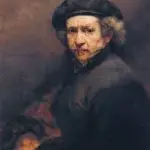
One of the most valuable invitations I have received along my journey is the invitation to embrace paradox.
What is a paradox, you ask? A paradox is when any two or more contradictory phenomena coexist within the same larger phenomenon. Linguistically, a paradox can be described as “both/and” instead of “either/or.” In terms of logical syllogism, sometimes “If this is true, then that is false” can become “Both this is true and that is true simultaneously.” This is the power of paradox.
My formal introduction to paradox occurred in the context of my Lutheran theological education. Christian teachings such as Jesus being both human and divine; Mary being both virgin and mother; or the Bible being both humanly written and divinely inspired are some examples of supernatural paradoxes within the Christian theological tradition. It is not necessary to accept any of these literally to witness the paradox in each case and observe its invitation to mystery.
Paradoxes in nature include the destructive force of earthquake, tornado, and flash flood alongside nourishing soil, a gentle breeze, and life-giving rain. In the part of Texas where I live, I experienced a natural paradox this week with the total solar eclipse. The sun did not stop shining and it simultaneously became dark in the middle of the day as the moon passed in front of it. The two great symbols of day and night appeared in the same spot at the same time. And everything is still okay. A beautiful paradox.
Spiritual Naturalism itself involves a paradox. Many spiritual people might consider naturalism incompatible with spirituality. Rejection of the material world has been a hallmark of some religious traditions—especially the three Western Abrahamic faiths. Conversely, many naturalists have lumped all spirituality in with super-naturalism rejecting any kind of spiritual practice out of hand as useless superstition.
Here in the Spiritual Naturalist Society we have found that a naturalistic perspective can helpfully exist alongside robust spiritual practices. In fact, many of us find that naturalism and spirituality beautifully compliment one another not as a mere intellectual exercise, but because we are actually doing it in the way we think and feel and live each day.
We human beings are a mass of paradoxes ourselves, aren’t we? Spirit and flesh; reason and faith; hopes together with fears; an immense capacity for destructiveness and also for great kindness; trauma and pain alongside serenity and peace. Consider the complexity of our desires. Much of the time we do not even know what we want. When we are able to settle on something, or at least begin heading in a particular direction, competing desires arise that cause us to re-evaluate and re-prioritize. Paradoxes arise when things which have no reason to seem connected are somehow able to coexist.
For me, it has taken a lot of practice to get used to paradox. The reason is my Western cultural context has conditioned me to try and resolve paradox whenever I encounter it. I must be only kind and never destructive. If I rely on reason for guidance that necessarily cancels out faith. Am I only brain and body or also a heart and mind? How can I possibly ever find peace when I am in so much pain? And in each case, the vice-versa. Because paradox involves tension, and we don’t like tension, our brains want to resolve the tension by choosing either one phenomenon or the other. We want a vote! And for there to be a winner! And a loser!
As satisfying as this all-or-nothing proposition may seem, the wisdom of paradox introduces us to the value of spectrum. The spectrum of rain includes light mist, shower, downpour, severe thunderstorm, and deluge. Likewise with wind: zephyr, gust, gale-force, tornado, and hurricane. So, where do you find yourself along the spectrum of your own paradoxes such as the physical and spiritual; hope and fear; pain and peace; faith and reason? Experience reveals that denying and repressing one phenomenon or another will only cause it to insist on asserting itself in subconscious ways. Accepting ourselves as we are, with all our mass of contradictions—this is the invitation of paradox.
Embracing paradox involves finding ways of making peace with the tension instead of always trying to resolve it. To help me make this peace, I often repeat this affirmation I once read: “More than one thing can be true at the same time.”
The Anchoring Heart Technique—developed by Deborah Grassman in her work with military veterans in hospice—is a practical practice of embracing paradox. (1) It is a human practice of becoming consciously aware of physical tension while simultaneously introducing the mystery of peace. Very simply, it is a way of allowing peace and pain to coexist within you. Here are the instructions:
- Place one hand or both hands firmly and tenderly over your heart. Breathe deeply.
- Feel whatever you are experiencing, even if it’s just for a few seconds.
- Be curious about the place inside you that is strong enough to hold your pain without fear. Get to know your BRAVE SPACE. (2)
That’s it. That’s the whole practice. Even if we don’t consciously recognize the contradictory phenomena producing the tension within us, we feel them. The aches and pains in our bodies. Digestive upset. Muscle tension. Migraine headaches. High blood pressure. Racing thoughts. Our physical bodies keep the score of all our physical, emotional, psychological, and spiritual traumas. When the paradox threatens to overwhelm, it takes all our wisdom and compassion to practice staying in our own skin.
The good news is we already have that wisdom and compassion within us. We already know how to anchor our hearts. The simple steps described above are the conscious practice of it. I invite you to try anchoring your own heart and see how you feel. Morning, evening, and throughout the day—especially when the going gets tough. However you practice embracing paradox, may peace be with you.
__________
Learn about Membership in the Spiritual Naturalist Society
The Spiritual Naturalist Society works to spread awareness of spiritual naturalism as a way of life, develop its thought and practice, and help bring together like-minded practitioners in fellowship.
SNS strives to include diverse voices within the spectrum of naturalistic spirituality. Authors will vary in their opinions, terms, and outlook. The views of no single author therefore necessarily reflect those of all Spiritual Naturalists or of SNS.
__________
Notes:
- Read more about Anchoring Your Heart online at: https://opuspeace.org/soul-injury-inventory/soul-restoring-resources/anchoring-heart/.
- Watch this brief video (11:44 min.) in which Deborah Grassman guides the Anchoring Heart Technique using the steps described above: https://opuspeace.newzenler.com/courses/anchoring-heart-technique?_ga=2.191433770.1669155723.1712498474-781013828.1711986217.












